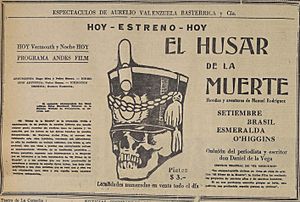El Húsar de la Muerte facts for kids
El Húsar de la Muerte means The Hussar of Death in English. It's a Chilean silent film from 1925. Pedro Sienna directed it and also starred in it. The movie tells the exciting story of Manuel Rodríguez. He was a brave guerrilla leader during a time called the Reconquista in Chile. The film shows his adventures until he died in 1818.
It first showed in Santiago, Chile, on November 24, 1925.
Contents
What the Movie is About
The film starts after the Battle of Rancagua in 1814. In this battle, the royalist army won against the Chilean forces. Even after their victory, Manuel Rodríguez sends a message to the royalists. He warns them that their control will soon end. He tells them that freedom for Chile is very close.
The Chilean patriots feel hopeful when Rodríguez visits them. He shares his plans to meet San Martín in Mendoza. They need to discuss their next steps for Chile's independence.
Rodríguez's Adventures
When Rodríguez returns, he defeats two royalist soldiers. This makes the royalists, especially Captain Vicente San Bruno, very worried. To avoid being caught, Rodríguez often uses disguises. During his adventures, he falls in love with Carmen de Aguirre. She is the daughter of the Marquis of Aguirre.
Rodríguez starts to gather brave patriots to fight for Chile's freedom. One person who joins his rebellion is a young boy known as "el huacho pelao." Meanwhile, the royalists are always trying to catch Rodríguez. But he is very clever and always manages to escape them.
Stealing Important Documents
Rodríguez even sneaks into Governor Francisco Casimiro Marco del Pont's house. He is in disguise and manages to steal important documents. "El huacho pelao" helps him with this risky mission. The governor offers a reward to anyone who can capture Rodríguez. One of Rodríguez's own men tries to betray him. However, Rodríguez finds out about the betrayal before the authorities arrive.
The royalists finally corner Rodríguez at the Aguirre family's home. He gets wounded there, and Carmen takes care of him. When Captain San Bruno questions him, Rodríguez defeats him in a sword fight. He says goodbye to Carmen before leaving for Mendoza. He needs to give the stolen documents to San Martín.
The End of the Story
The movie finishes with text on screen explaining what happened next. It mentions the Battle of Maipú and Bernardo O'Higgins becoming a leader. A scene shows a soldier telling his friends about Rodríguez's death. Then, they bury him.
How the Film Was Made and Saved
The director, Pedro Sienna, chose the actors for the movie in an interesting way. He found many of them from people he met on the street.
For a long time, people thought the film was lost forever. But in 1959, it was found! It was in very bad condition, and some of the title cards (the text shown in silent films) were missing. Luckily, with Pedro Sienna's help, the film was fixed up in 1962. The Cineteca de la Universidad de Chile restored it. Sergio Ortega also added music to it, with help from the Chilean government.
Main Actors
| Actor | Character |
|---|---|
| Pedro Sienna | Manuel Rodríguez |
| Clara Werther | Carmen de Aguirre |
| Piet Van Ravenstein | |
| Guillermo Barrientos | El Huacho Pelao |
| María de Hanning | |
| Dolores Anziani | Charito |
| Hugo Silva | Home making - Patriotical |
| Piet van Ravebstein | |
| Luis Baeza | |
| Octavio Soto | |
| Federico Geimza | |
| Guillermo Barrientos | |
| Guillermo Barrientos | |
| Emilia Sierra | |
| Ángel Díaz | |
| Víctor Véjar |
See also
 In Spanish: El húsar de la muerte para niños
In Spanish: El húsar de la muerte para niños



